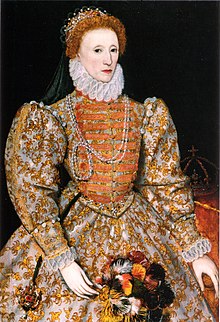
Back Elizabeth I van Engeland Afrikaans Elisabeth I. ALS ኤልዛቤት I Amharic Isabel I d'Anglaterra AN Elisabeþ I Engla Cwen ANG إليزابيث الأولى ملكة إنجلترا Arabic اليزابيث الاولى ملكة انجلترا ARZ Sabela I d'Inglaterra AST I Elizabet Azerbaijani بیرینجی الیزابت (بریتانیا) AZB
| Elizabeth I | |
|---|---|
 The Darnley Portrait, c. 1575 | |
| Queen of England and Ireland | |
| Reign | 17 November 1558 – 24 March 1603 |
| Coronation | 15 January 1559 |
| Predecessor | Mary I |
| Successor | James I |
| Born | 7 September 1533 Palace of Placentia, Greenwich, England |
| Died | 24 March 1603 (aged 69) Richmond Palace, Surrey, England |
| Burial | 28 April 1603 |
| House | Tudor |
| Father | Henry VIII of England |
| Mother | Anne Boleyn |
| Religion | Anglicanism |
| Signature | |
Elizabeth I (7 September 1533 – 24 March 1603)[a] was Queen of England and Ireland from 17 November 1558 until her death in 1603. She was the last monarch of the House of Tudor.
Elizabeth was the only surviving child of Henry VIII and his second wife, Anne Boleyn. When Elizabeth was two years old, her parents' marriage was annulled, her mother was executed, and Elizabeth was declared illegitimate. Henry restored her to the line of succession when she was 10, via the Third Succession Act 1543. After Henry's death in 1547, Elizabeth's younger half-brother Edward VI ruled until his own death in 1553, bequeathing the crown to a Protestant cousin, Lady Jane Grey, and ignoring the claims of his two half-sisters, the Catholic Mary and the younger Elizabeth, in spite of statutes to the contrary. Edward's will was set aside within weeks of his death and Mary became queen, deposing and executing Jane. During Mary's reign, Elizabeth was imprisoned for nearly a year on suspicion of supporting Protestant rebels.
Upon her half-sister's death in 1558, Elizabeth succeeded to the throne and set out to rule by good counsel.[b] She depended heavily on a group of trusted advisers led by William Cecil, whom she created Baron Burghley. One of her first actions as queen was the establishment of an English Protestant church, of which she became the supreme governor. This era, later named the Elizabethan Religious Settlement, would evolve into the Church of England. It was expected that Elizabeth would marry and produce an heir; however, despite numerous courtships, she never did. Because of this she is sometimes referred to as the "Virgin Queen".[2] She was eventually succeeded by her first cousin twice removed, James VI of Scotland, the son of Mary, Queen of Scots.
In government, Elizabeth was more moderate than her father and siblings had been.[3] One of her mottoes was video et taceo ("I see and keep silent").[4] In religion, she was relatively tolerant and avoided systematic persecution. After the pope declared her illegitimate in 1570, which in theory released English Catholics from allegiance to her, several conspiracies threatened her life, all of which were defeated with the help of her ministers' secret service, run by Sir Francis Walsingham. Elizabeth was cautious in foreign affairs, manoeuvring between the major powers of France and Spain. She half-heartedly supported a number of ineffective, poorly resourced military campaigns in the Netherlands, France, and Ireland. By the mid-1580s, England could no longer avoid war with Spain.
As she grew older, Elizabeth became celebrated for her virginity. A cult of personality grew around her which was celebrated in the portraits, pageants, and literature of the day. Elizabeth's reign became known as the Elizabethan era. The period is famous for the flourishing of English drama, led by playwrights such as William Shakespeare and Christopher Marlowe, the prowess of English maritime adventurers, such as Francis Drake and Walter Raleigh, and for the defeat of the Spanish Armada. Some historians depict Elizabeth as a short-tempered, sometimes indecisive ruler,[5] who enjoyed more than her fair share of luck. Towards the end of her reign, a series of economic and military problems weakened her popularity. Elizabeth is acknowledged as a charismatic performer ("Gloriana") and a dogged survivor ("Good Queen Bess") in an era when government was ramshackle and limited, and when monarchs in neighbouring countries faced internal problems that jeopardised their thrones. After the short, disastrous reigns of her half-siblings, her 44 years on the throne provided welcome stability for the kingdom and helped to forge a sense of national identity.[3]
Cite error: There are <ref group=lower-alpha> tags or {{efn}} templates on this page, but the references will not show without a {{reflist|group=lower-alpha}} template or {{notelist}} template (see the help page).
- ^ Elizabeth's first speech as queen, Hatfield House, 20 November 1558. Loades, 35.
- ^ "House of Tudor | History, Monarchs, & Facts". Encyclopedia Britannica. Archived from the original on 24 August 2021. Retrieved 31 August 2021.
- ^ a b Starkey Elizabeth: Woman, 5.
- ^ Neale, 386.
- ^ Somerset, 729.